Fixed-Bed Adsorption of Phenol onto Microporous Activated Carbon Set from Rice Husk Using Chemical Activation
Abstract
:1. Introduction
2. Materials and Methods
2.1. Chemicals
2.2. Preparation of Chemicals Activated Carbon
2.3. Activated Carbon Characterization
2.4. Adsorption Column (Fixed Bed)
2.5. Fixed-Bed Column Analysis Breakthrough
2.6. Desorption Studies
2.7. Adsorption Column Modeling
2.7.1. Model of Yoon–Nelson
2.7.2. Model of Adams–Bohart
2.7.3. BDST Model
3. Results
3.1. Physical Morphology of the Surface
3.2. Isotherms of Nitrogen Adsorption and Physical Properties
3.3. Identification and Structural Analysis of Rice Husk Activated Carbon
3.4. Studies of Fixed-Bed Column
3.4.1. Concentration Effect of the Influent Phenol on the Curve of Breakthrough
3.4.2. The Rate of Flow Effect
3.4.3. The Bed Depth Effect
3.5. Study of Desorption
3.6. Curve of Breakthrough Modeling
3.6.1. Yoon–Nelson Model Application
3.6.2. The Adams–Bohart Model Application
3.6.3. The BDST Model Application
4. Discussion
5. Conclusions
Author Contributions
Funding
Institutional Review Board Statement
Informed Consent Statement
Data Availability Statement
Acknowledgments
Conflicts of Interest
References
- Mishra, S.; Yadav, S.S.; Rawat, S.; Singh, J.; Koduru, J.R. Corn husk derived magnetized activated carbon for the removal of phenol and para-nitrophenol from aqueous solution: Interaction mechanism, insights on adsorbent characteristics, and isothermal, kinetic and thermodynamic properties. J. Environ. Manag. 2019, 246, 362–373. [Google Scholar] [CrossRef] [PubMed]
- Chen, D.; Kannan, K.; Tan, H.; Zheng, Z.; Feng, Y.L.; Wu, Y.; Widelka, M. Review of the Bisphenol analogues other than BPA: Environmental occurrence, human exposure, and toxicity. Environ. Sci. Technol. 2016, 50, 5438–5453. [Google Scholar] [CrossRef] [PubMed]
- Nirmala, G.; Murugesan, T.; Rambabu, K.; Sathiyanarayanan, K.; Show, P.L. Adsorptive removal of phenol using banyan root activated carbon. Chem. Eng. Commun. 2021, 208, 831–842. [Google Scholar] [CrossRef]
- Busca, G.; Berardinelli, S.; Resini, C.; Arrighi, L. A short review of recent developments: Technologies for the removal of phenol from fluid streams. J. Hazard. Mater. 2008, 160, 265–288. [Google Scholar] [CrossRef]
- Stasinakis, A.S.; Elia, I.; Petalas, A.V.; Halvadakis, C.P. Removal of total phenols from olive-mill wastewater using an agricultural by-product, olive pomace. J. Hazard. Mater. 2008, 160, 408–413. [Google Scholar] [CrossRef]
- Priya, D.S.; Sureshkumar, M.V. Synthesis of Borassus flabellifer fruit husk activated carbon filter for phenol removal from wastewater. Int. J. Environ. Sci. Technol. 2020, 17, 829–842. [Google Scholar] [CrossRef]
- El-Naas, M.H.; Al-Zuhair, S.; Alhaija, M.A. Removal of phenol from petroleum refinery wastewater through adsorption on date-pit activated carbon. Chem. Eng. J. 2010, 162, 997–1005. [Google Scholar] [CrossRef]
- Aksu, Z. A review: Application of biosorption for the removal of organic pollutants. Process Biochem. 2005, 40, 997–1026. [Google Scholar] [CrossRef]
- Cordova-Rosa, S.M.; Dams, R.I.; Cordova-Rosa, E.V.; Radetski, M.R.; Corrêa, A.X.R.; Radetski, C.M. Remediation of phenol-contaminated soil by a bacterial consortium and Acinetobacter calcoaceticus isolated from an industrial wastewater treatment plant. J. Hazard. Mater. 2009, 164, 61–66. [Google Scholar] [CrossRef]
- Garcia-Castello, E.; Cassano, A.; Criscuoli, A.; Conidi, C.; Drioli, E. Recovery and concentration of polyphenols from olive mill wastewaters by integrated membrane system. Water Res. 2010, 44, 3883–3892. [Google Scholar] [CrossRef]
- Jain, A.K.; Bhatnagar, A. Methylphenols removal from water by low-cost adsorbents. J. Colloid Interface Sci. 2002, 251, 39–45. [Google Scholar] [CrossRef] [PubMed]
- Kujawski, W.; Warszawski, A.; Ratajczak, W.; Porębski, T.; Capała, W.; Ostrowska, I. Removal of phenol from wastewater by different separation techniques. Desalination 2004, 163, 287–296. [Google Scholar] [CrossRef]
- Hameed, B.H.; Rahman, A.A. Removal of phenol from aqueous solutions by adsorption onto activated carbon prepared from biomass material. J. Hazard. Mater. 2008, 160, 576–581. [Google Scholar] [CrossRef] [PubMed]
- Kumar, A.; Jena, H.M. Preparation and characterization of high surface area activated carbon from Fox nut (Euryale ferox) shell by chemical activation with H3PO4. Results Phys. 2016, 6, 651–658. [Google Scholar] [CrossRef] [Green Version]
- Kavand, M.; Soleimani, M.; Kaghazchi, T.; Asasian, N. Competitive separation of lead, cadmium, and nickel from aqueous solutions using activated carbon: Response surface modeling, equilibrium, and thermodynamic studies. Chem. Eng. Commun. 2016, 203, 123–135. [Google Scholar] [CrossRef]
- Krishnamoorthy, R.; Govindan, B.; Banat, F.; Sagadevan, V.; Purushothaman, M.; Show, P.L. Date pits activated carbon for divalent lead ions removal. J. Biosci. Bioeng. 2019, 128, 88–97. [Google Scholar] [CrossRef] [PubMed]
- Mohanty, K.; Jha, M.; Meikap, B.C.; Biswas, M.N. Removal of chromium (VI) from dilute aqueous solutions by activated carbon developed from Terminalia arjuna nuts activated with zinc chloride. Chem. Eng. Sci. 2005, 60, 3049–3059. [Google Scholar] [CrossRef]
- Azevedo, D.C.; Araújo, J.C.S.; Bastos-Neto, M.; Torres, A.E.B.; Jaguaribe, E.F.; Cavalcante, C.L. Microporous activated carbon prepared from coconut shells using chemical activation with zinc chloride. Microporous Mesoporous Mater. 2007, 100, 361–364. [Google Scholar] [CrossRef]
- Adinata, D.; Daud, W.M.A.W.; Aroua, M.K. Preparation and characterization of activated carbon from palm shell by chemical activation with K2CO3. Bioresour. Technol. 2007, 98, 145–149. [Google Scholar] [CrossRef]
- Prahas, D.; Kartika, Y.; Indraswati, N.; Ismadji, S.J.C.E.J. Activated carbon from jackfruit peel waste by H3PO4 chemical activation: Pore structure and surface chemistry characterization. Chem. Eng. J. 2008, 140, 32–42. [Google Scholar] [CrossRef]
- Kalderis, D.; Bethanis, S.; Paraskeva, P.; Diamadopoulos, E. Production of activated carbon from bagasse and rice husk by a single-stage chemical activation method at low retention times. Bioresour. Technol. 2008, 99, 6809–6816. [Google Scholar] [CrossRef] [PubMed]
- Altenor, S.; Carene, B.; Emmanuel, E.; Lambert, J.; Ehrhardt, J.J.; Gaspard, S. Adsorption studies of methylene blue and phenol onto vetiver roots activated carbon prepared by chemical activation. J. Hazard. Mater. 2009, 165, 1029–1039. [Google Scholar] [CrossRef]
- Din, A.T.M.; Hameed, B.H.; Ahmad, A.L. Batch adsorption of phenol onto physiochemical-activated coconut shell. J. Hazard. Materials 2009, 161, 1522–1529. [Google Scholar]
- Liou, T.H.; Wu, S.J. Characteristics of microporous/mesoporous carbons prepared from rice husk under base-and acid-treated conditions. J. Hazard. Mater. 2009, 171, 693–703. [Google Scholar] [CrossRef] [PubMed]
- Karunarathne, H.D.S.S.; Amarasinghe, B.M.W.P.K. Fixed bed adsorption column studies for the removal of aqueous phenol from activated carbon prepared from sugarcane bagasse. Energy Procedia 2013, 34, 83–90. [Google Scholar] [CrossRef] [Green Version]
- Girish, C.R.; Ramachandra Murty, V. Adsorption of phenol from aqueous solution using Lantana camara, forest waste: Kinetics, isotherm, and thermodynamic studies. Int. Sch. Res. Not. 2014, 2014, 201626. [Google Scholar]
- Liou, T.H. Development of mesoporous structure and high adsorption capacity of biomass-based activated carbon by phosphoric acid and zinc chloride activation. Chem. Eng. J. 2010, 158, 129–142. [Google Scholar] [CrossRef]
- Kumar, U.; Bandyopadhyay, M. Sorption of cadmium from aqueous solution using pretreated rice husk. Bioresour. Technol. 2006, 97, 104–109. [Google Scholar] [CrossRef]
- Ngah, W.W.; Hanafiah, M.M. A review: Removal of heavy metal ions from wastewater by chemically modified plant wastes as adsorbents. Bioresour. Technol. 2008, 99, 3935–3948. [Google Scholar] [CrossRef]
- Wong, K.K.; Lee, C.K.; Low, K.S.; Haron, M.J. Removal of Cu and Pb by tartaric acid modified rice husk from aqueous solutions. Chemosphere. 2003, 50, 23–28. [Google Scholar] [CrossRef]
- Miao, Q.; Tang, Y.; Xu, J.; Liu, X.; Xiao, L.; Chen, Q. Activated carbon prepared from soybean straw for phenol adsorption. J. Taiwan Inst. Chem. Eng. 2013, 44, 458–465. [Google Scholar] [CrossRef]
- Komal Kumar, N.; Shukla, V.K. Electrode material for supercapacitor using activated carbon derived from flower of Achyranthes aspera L. Proc. AIP Conf. 2020, 2220, 140046. [Google Scholar]
- Joshi, S.; Bishnu, K.C. Synthesis and Characterization of Sugarcane Bagasse Based Activated Carbon: Effect of Impregnation Ratio of ZnCl2. J. Nepal Chem. Soc. 2020, 41, 74–79. [Google Scholar] [CrossRef]
- Daffalla, S.B.; Mukhtar, H.; Shaharun, M.S. Properties of activated carbon prepared from rice husk with chemical activation. Int. J. Glob. Environ. Issues 2012, 12, 107–129. [Google Scholar] [CrossRef]
- Luo, X.; Deng, Z.; Lin, X.; Zhang, C. Fixed-bed column study for Cu2+ removal from solution using expanding rice husk. J. Hazard. Mater. 2011, 187, 182–189. [Google Scholar] [CrossRef]
- Aksu, Z.; Gönen, F. Biosorption of phenol by immobilized activated sludge in a continuous packed bed: Prediction of breakthrough curves. Process Biochem. 2004, 39, 599–613. [Google Scholar] [CrossRef]
- Shi, S.L.; Lv, J.P.; Liu, Q.; Nan, F.R.; Jiao, X.Y.; Feng, J.; Xie, S.L. Application of Phragmites australis to remove phenol from aqueous solutions by chemical activation in batch and fixed-bed columns. Environ. Sci. Pollut. Res. 2018, 25, 23917–23928. [Google Scholar] [CrossRef]
- Oguz, E.; Ersoy, M. Removal of Cu2+ from aqueous solution by adsorption in a fixed bed column and Neural Network Modelling. Chem. Eng. J. 2010, 164, 56–62. [Google Scholar] [CrossRef]
- Dwivedi, C.P.; Sahu, J.N.; Mohanty, C.R.; Mohan, B.R.; Meikap, B.C. Column performance of granular activated carbon packed bed for Pb (II) removal. J. Hazard. Mater. 2008, 156, 596–603. [Google Scholar] [CrossRef]
- Han, R.; Ding, D.; Xu, Y.; Zou, W.; Wang, Y.; Li, Y.; Zou, L. Use of rice husk for the adsorption of congo red from aqueous solution in column mode. Bioresour. Technol. 2008, 99, 2938–2946. [Google Scholar] [CrossRef]
- Mohan, S.; Sreelakshmi, G. Fixed bed column study for heavy metal removal using phosphate treated rice husk. J. Hazard. Mater. 2008, 153, 75–82. [Google Scholar] [CrossRef] [PubMed]
- Ren, L.; Zhang, J.; Li, Y.; Zhang, C. Preparation and evaluation of cattail fiber-based activated carbon for 2, 4-dichlorophenol and 2, 4, 6-trichlorophenol removal. Chem. Eng. J. 2011, 168, 553–561. [Google Scholar] [CrossRef]
- Pallarés, J.; González-Cencerrado, A.; Arauzo, I. Production and characterization of activated carbon from barley straw by physical activation with carbon dioxide and steam. Biomass Bioenergy 2018, 115, 64–73. [Google Scholar] [CrossRef] [Green Version]
- Nakbanpote, W.; Thiravetyan, P.; Kalambaheti, C. Preconcentration of gold by rice husk ash. Miner. Eng. 2000, 13, 391–400. [Google Scholar] [CrossRef]
- Chen, N.; Zhang, Z.; Feng, C.; Li, M.; Chen, R.; Sugiura, N. Investigations on the batch and fixed-bed column performance of fluoride adsorption by Kanuma mud. Desalination 2011, 268, 76–82. [Google Scholar] [CrossRef] [Green Version]
- Ahmad, A.A.; Hameed, B.H. Fixed-bed adsorption of reactive azo dye onto granular activated carbon prepared from waste. J. Hazard. Mater. 2010, 175, 298–303. [Google Scholar] [CrossRef]
- Sharma, N.; Kaur, K.; Kaur, S. Kinetic and equilibrium studies on the removal of Cd2+ ions from water using polyacrylamide grafted rice (Oryza sativa) husk and (Tectona grandis) saw dust. J. Hazard. Mater. 2009, 163, 1338–1344. [Google Scholar] [CrossRef]
- Bhaumik, M.; Setshedi, K.; Maity, A.; Onyango, M.S. Chromium (VI) removal from water using fixed bed column of polypyrrole/Fe3O4 nanocomposite. Sep. Purif. Technol. 2013, 110, 11–19. [Google Scholar] [CrossRef]
- Al-Degs, Y.S.; Khraisheh, M.A.M.; Allen, S.J.; Ahmad, M.N. Adsorption characteristics of reactive dyes in columns of activated carbon. J. Hazard. Mater. 2009, 165, 944–949. [Google Scholar] [CrossRef]
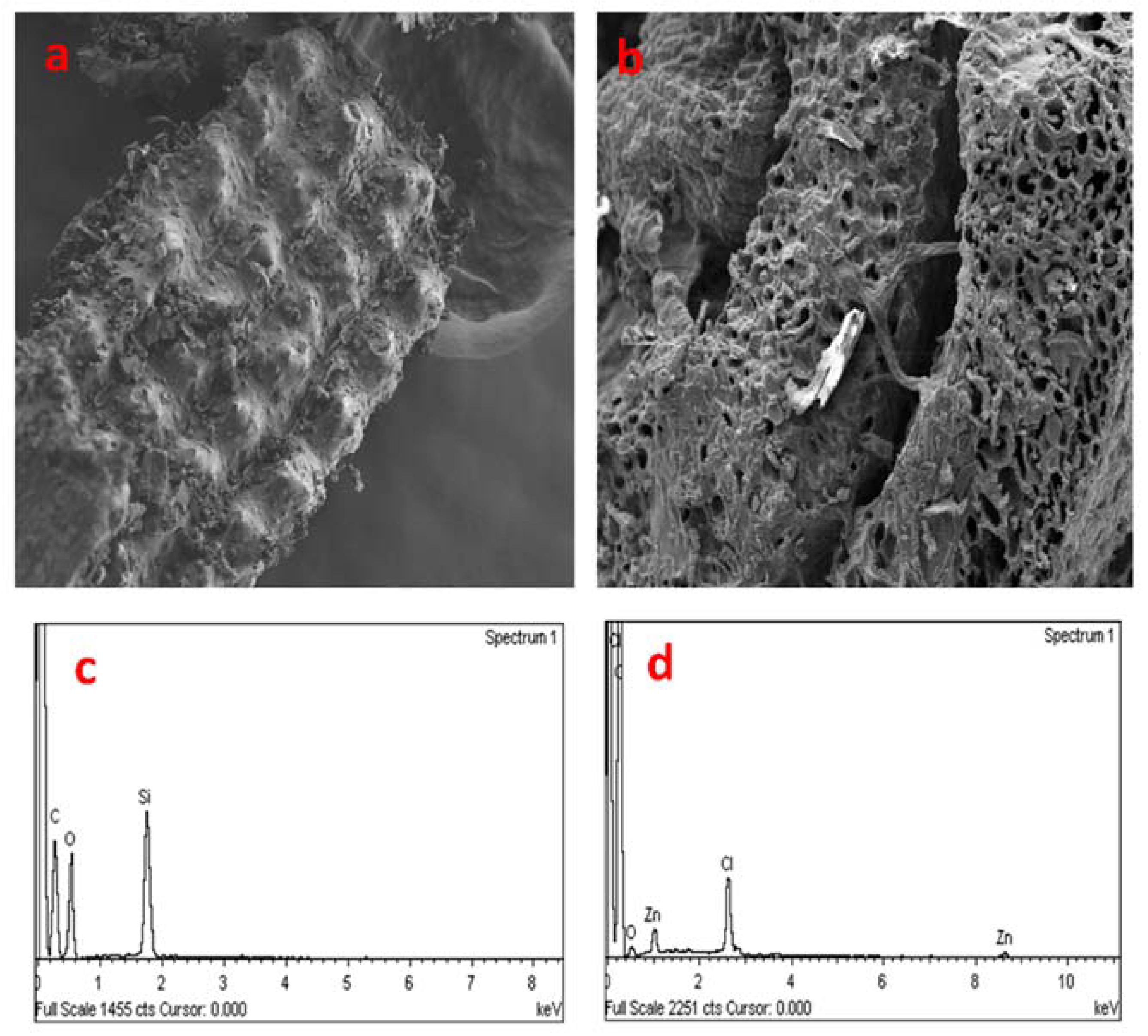
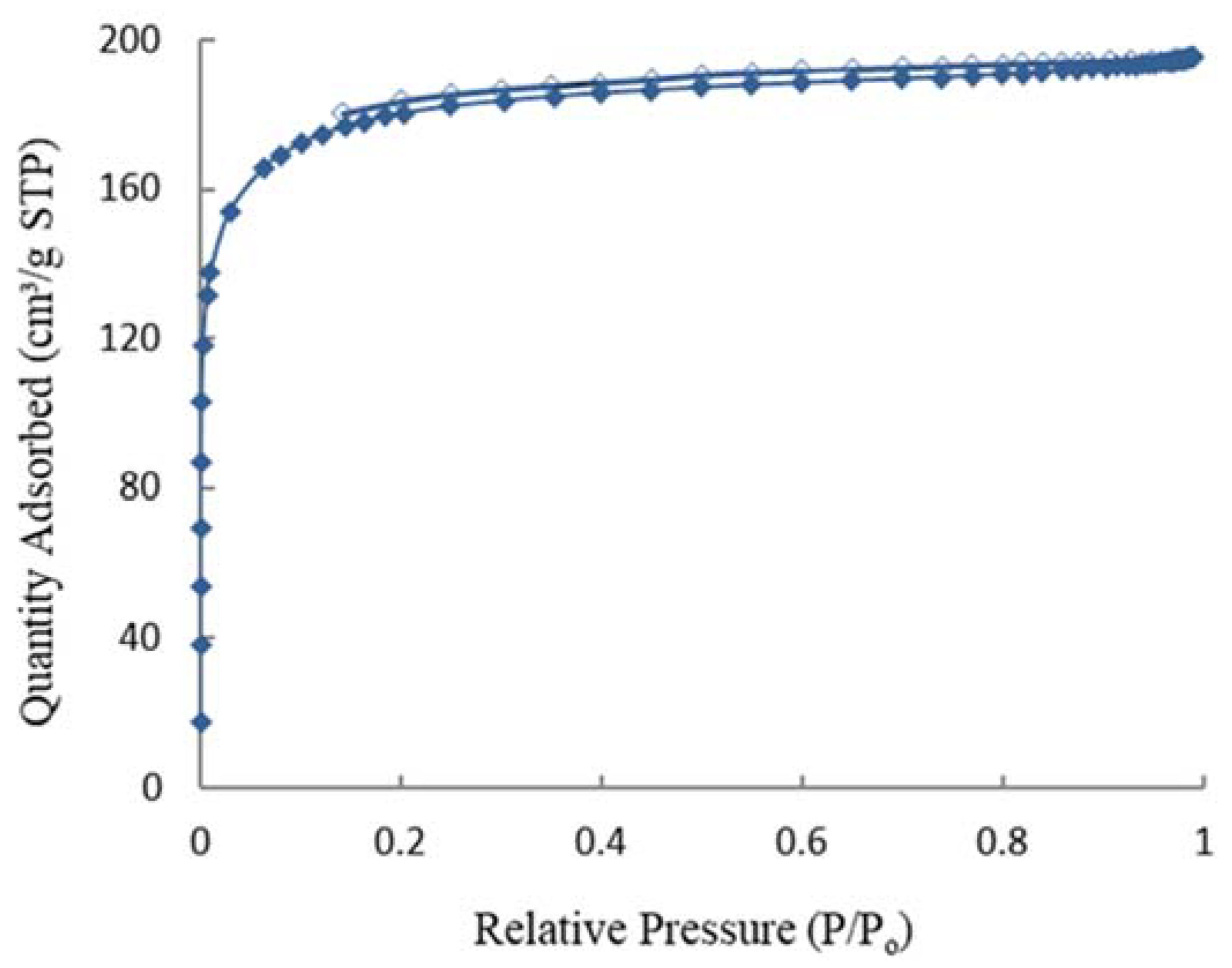
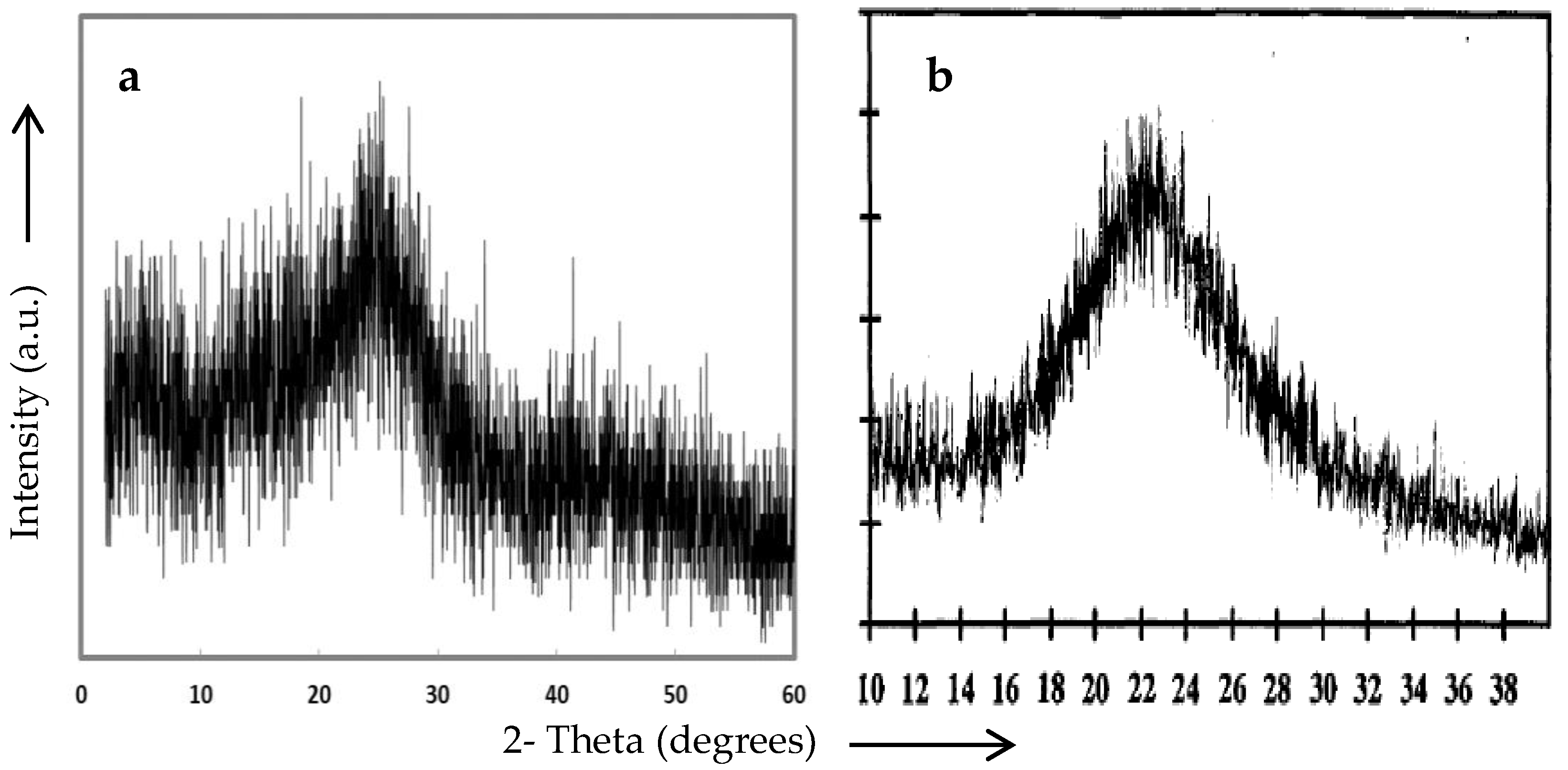

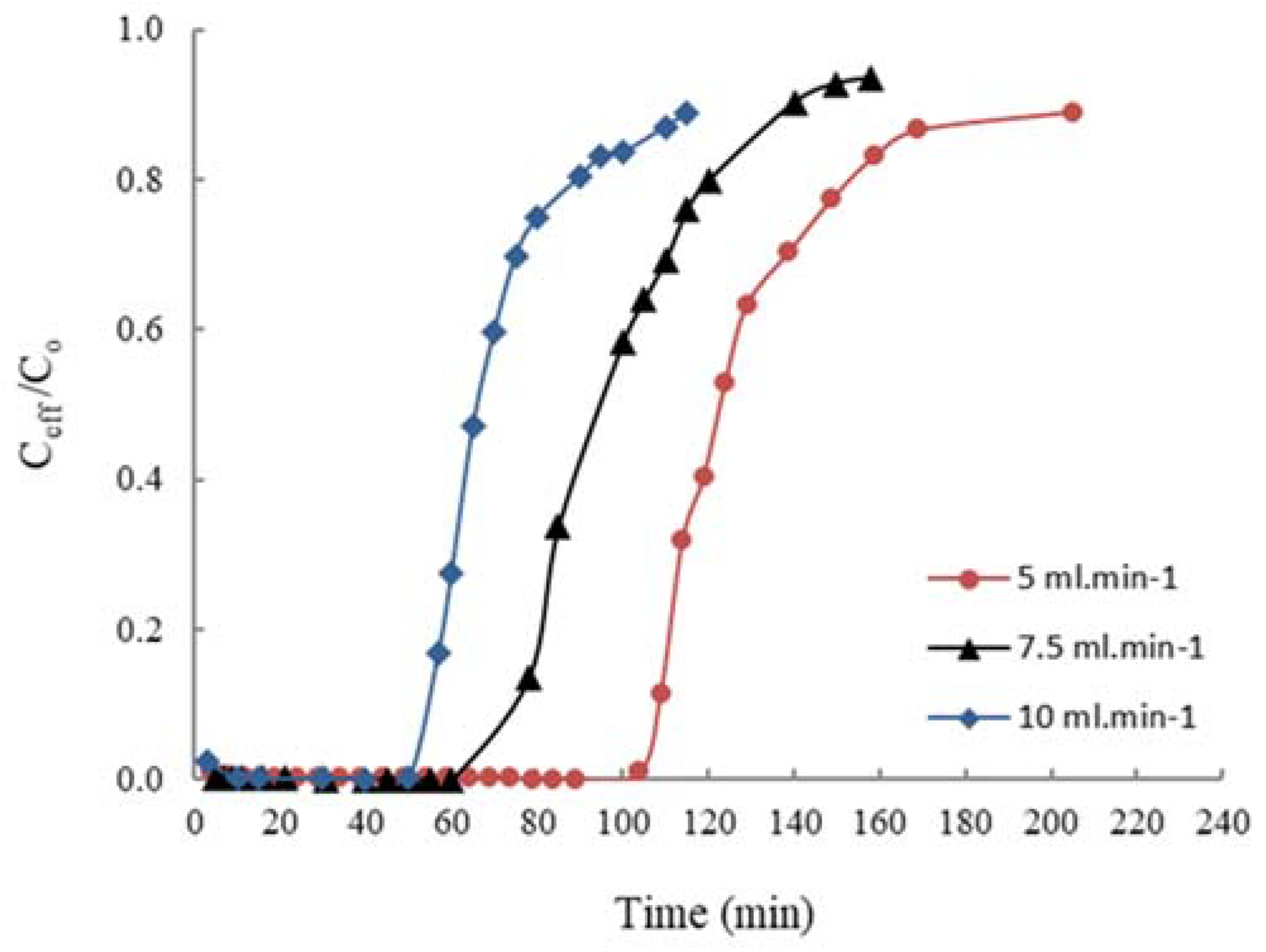
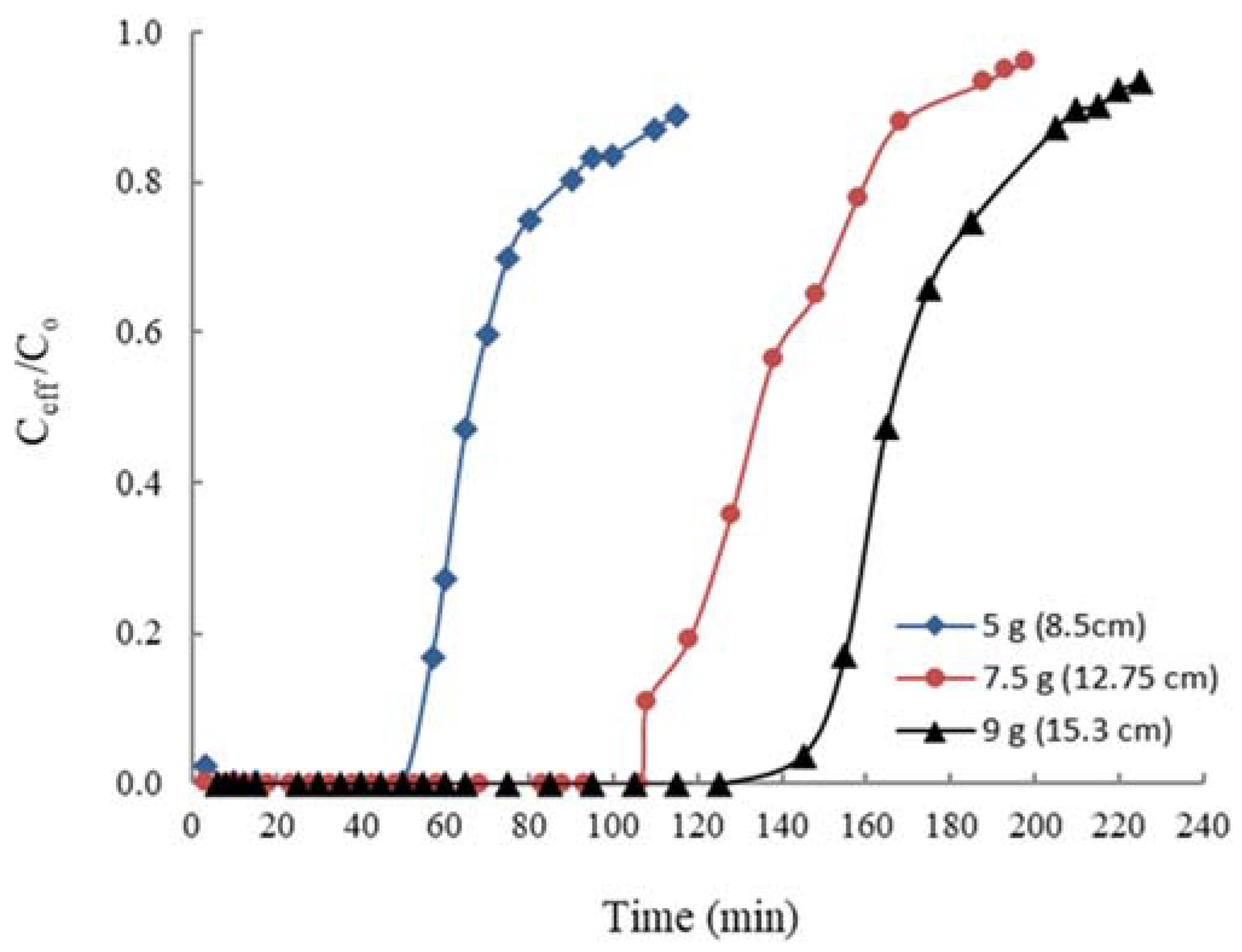
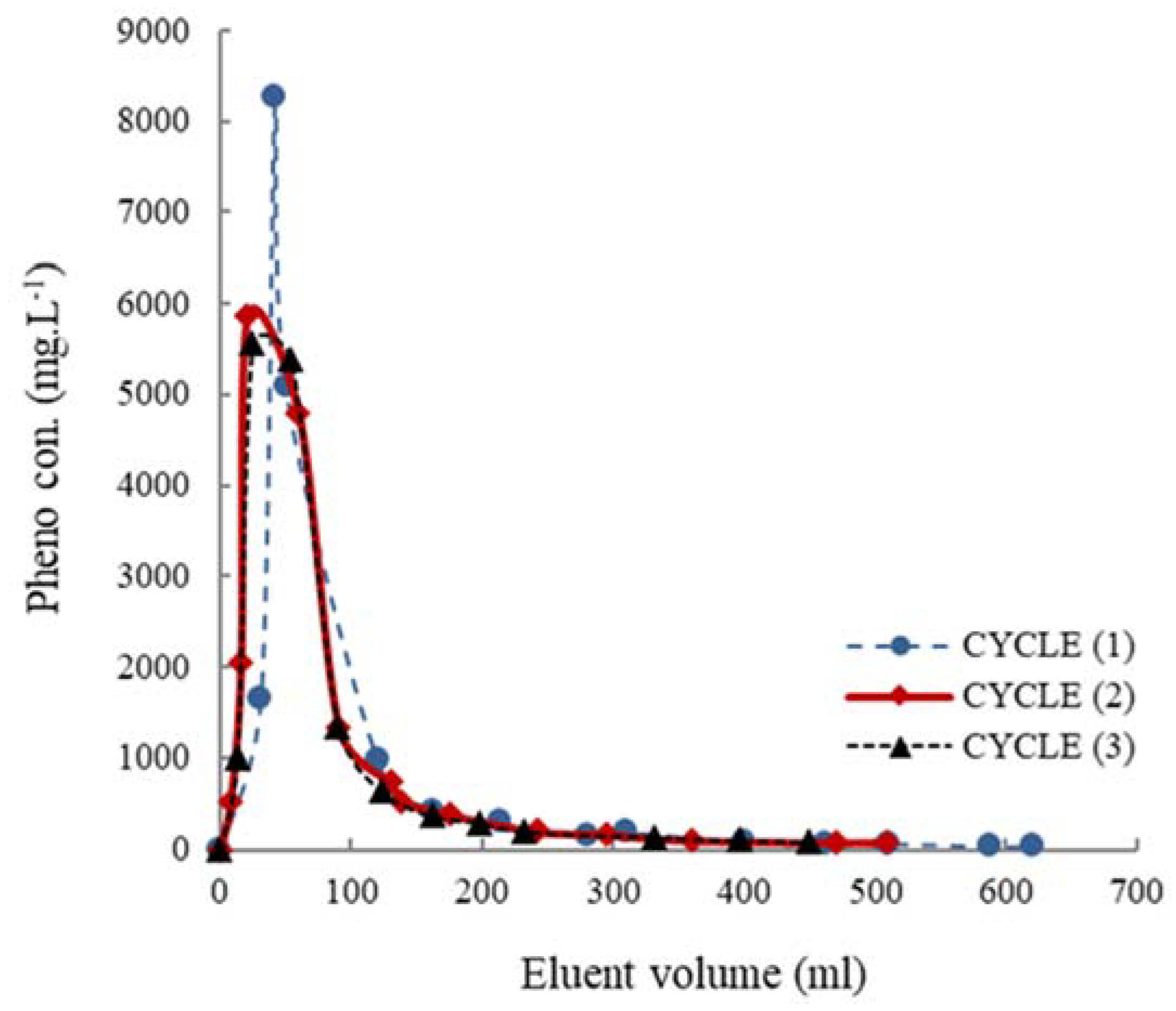

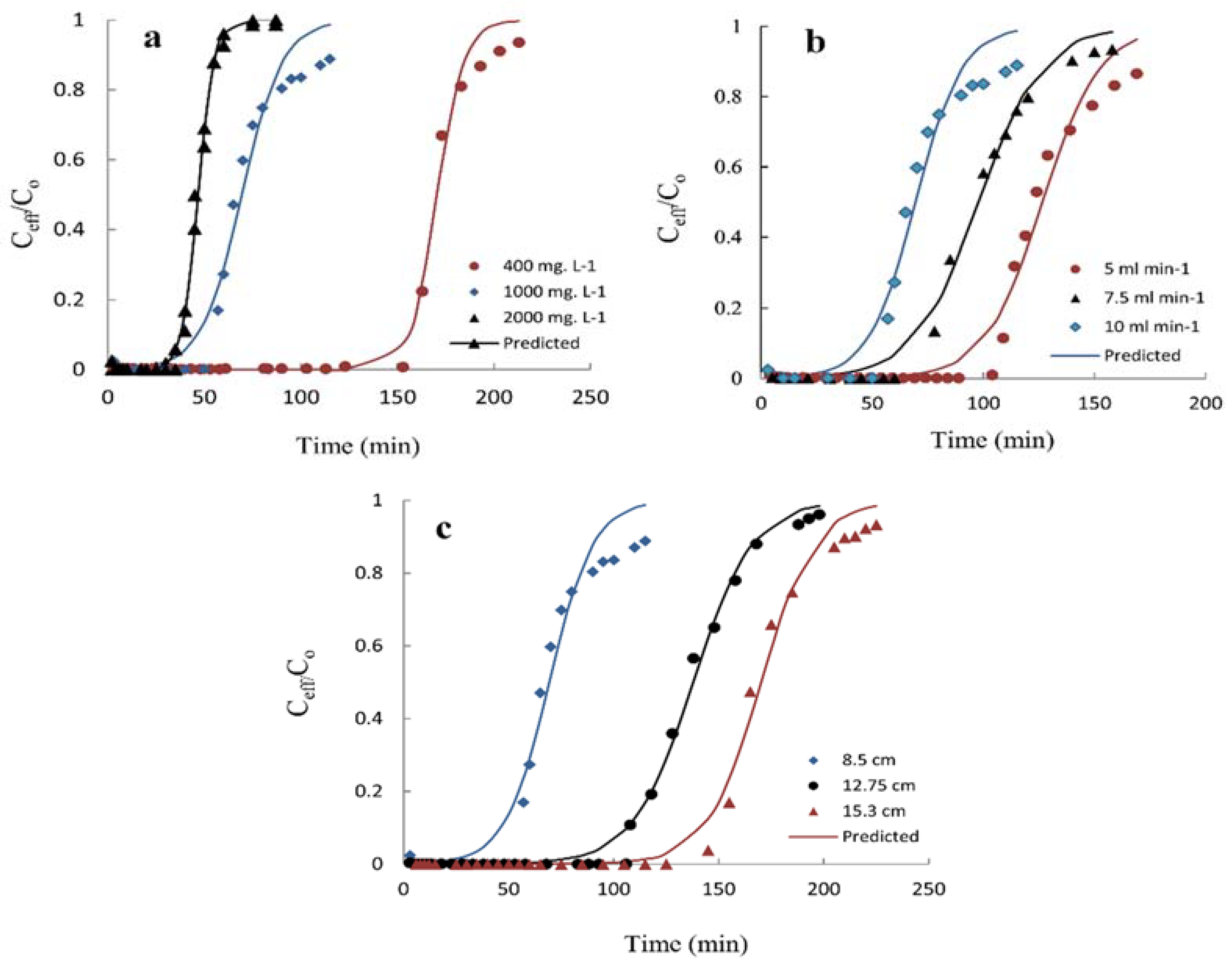


| Parameter | RH | RHAC |
|---|---|---|
| Surface area (m2·g−1) | 7.14 | 586.59 |
| Micropore area (m2·g−1) a | 1.44 | 415.80 |
| Micropore volume (cm3·g−1) a | 0.000 | 0.204 |
| Total pore volume (cm3·g−1) b | 0.006 | 0.301 |
| Average pore diameter (nm) c | 3.080 | 2.055 |
| Microporosity (%) d | 0.00 | 67.60 |
| C0 (mg·L−1) | v (mL·min−1) | Z (cm) | tb (min) | ttotal (min) | qtotal (mg) | qeq (mg·g−1) | Veff (mL) |
|---|---|---|---|---|---|---|---|
| 400 | 10.0 | 8.50 | 153 | 193 | 87.45 | 17.49 | 1930 |
| 1000 | 10.0 | 8.50 | 40 | 90 | 110.85 | 22.17 | 900 |
| 2000 | 10.0 | 8.50 | 35 | 60 | 228.95 | 45.79 | 600 |
| 1000 | 7.5 | 8.50 | 60 | 130 | 135.75 | 27.15 | 975 |
| 1000 | 5.0 | 8.50 | 84 | 149 | 152.05 | 30.41 | 745 |
| 1000 | 10.0 | 12.75 | 106 | 188 | 223.28 | 29.77 | 1880 |
| 1000 | 10.0 | 15.30 | 125 | 195 | 283.41 | 31.49 | 1950 |
| C0 (mg·L−1) | Q (mL·min−1) | Z (cm) | kYN (min−1) | τ (min) | R2 | τexp (min) | APE (%) |
|---|---|---|---|---|---|---|---|
| 1000 | 5.0 | 8.50 | 0.077 | 126.59 | 0.977 | 124 | 12.64 |
| 1000 | 7.5 | 8.50 | 0.069 | 97.81 | 0.992 | 100 | 4.89 |
| 1000 | 10.0 | 8.50 | 0.095 | 69.39 | 0.980 | 65 | 12.99 |
| 400 | 10.0 | 8.50 | 0.142 | 170.58 | 0.988 | 173 | 9.51 |
| 2000 | 10.0 | 8.50 | 0.239 | 46.67 | 0.992 | 45 | 4.73 |
| 1000 | 10.0 | 12.75 | 0.070 | 137.86 | 0.994 | 138 | 4.09 |
| 1000 | 10.0 | 15.30 | 0.077 | 170.21 | 0.989 | 165 | 11.02 |
| C0 (mg·L−1) | Q (mL·min−1) | Z (cm) | kAB × 104 (L·mg−1·min−1) | N0 × 10−4 (mg·L−1) | R2 |
|---|---|---|---|---|---|
| 1000 | 5.0 | 8.50 | 1.14 | 3.808 | 0.975 |
| 1000 | 7.5 | 8.50 | 0.59 | 4.887 | 0.981 |
| 1000 | 10.0 | 8.50 | 1.31 | 4.039 | 0.982 |
| 400 | 10.0 | 8.50 | 1.68 | 5.421 | 0.979 |
| 2000 | 10.0 | 8.50 | 1.52 | 5.776 | 0.997 |
| 1000 | 10.0 | 12.75 | 0.59 | 5.796 | 0.994 |
| 1000 | 10.0 | 15.30 | 1.07 | 5.096 | 0.999 |
| Ceff/C0 | K (L·mg−1·h−1) | Z0 (cm) | R2 | |
|---|---|---|---|---|
| 0.10 | 0.0108 | 62.048 | 4.0842 | 0.9975 |
| 0.60 | 0.0164 | 62.048 | 2.7089 | 0.9299 |
| 0.88 | 0.0171 | 74.673 | 2.1481 | 0.9665 |
Publisher’s Note: MDPI stays neutral with regard to jurisdictional claims in published maps and institutional affiliations. |
© 2022 by the authors. Licensee MDPI, Basel, Switzerland. This article is an open access article distributed under the terms and conditions of the Creative Commons Attribution (CC BY) license (https://creativecommons.org/licenses/by/4.0/).
Share and Cite
Daffalla, S.B.; Mukhtar, H.; Shaharun, M.S.; Hassaballa, A.A. Fixed-Bed Adsorption of Phenol onto Microporous Activated Carbon Set from Rice Husk Using Chemical Activation. Appl. Sci. 2022, 12, 4354. https://doi.org/10.3390/app12094354
Daffalla SB, Mukhtar H, Shaharun MS, Hassaballa AA. Fixed-Bed Adsorption of Phenol onto Microporous Activated Carbon Set from Rice Husk Using Chemical Activation. Applied Sciences. 2022; 12(9):4354. https://doi.org/10.3390/app12094354
Chicago/Turabian StyleDaffalla, Samah B., Hilmi Mukhtar, Maizatul S. Shaharun, and Abdalhaleem A. Hassaballa. 2022. "Fixed-Bed Adsorption of Phenol onto Microporous Activated Carbon Set from Rice Husk Using Chemical Activation" Applied Sciences 12, no. 9: 4354. https://doi.org/10.3390/app12094354
APA StyleDaffalla, S. B., Mukhtar, H., Shaharun, M. S., & Hassaballa, A. A. (2022). Fixed-Bed Adsorption of Phenol onto Microporous Activated Carbon Set from Rice Husk Using Chemical Activation. Applied Sciences, 12(9), 4354. https://doi.org/10.3390/app12094354







